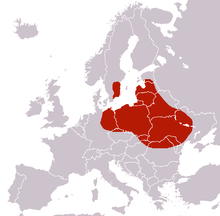Porphyrophora polonica
| Porphyrophora polonica | ||||||||||||
|---|---|---|---|---|---|---|---|---|---|---|---|---|

Life cycle |
||||||||||||
| Systematics | ||||||||||||
|
||||||||||||
| Scientific name | ||||||||||||
| Porphyrophora polonica | ||||||||||||
| ( Linnaeus , 1758) |
Porphyrophora polonica , sometimes as Polish Karminschildlaus or Kermeslaus called, is a type of the superfamily of scale insects . The species was very important in the Middle Ages and early modern times because it provided a red dye ( carmine ). Its importance in Europe diminished somewhat whenthe easy-to-keep cochineal scale became knownin the New World in the 16th century.
Life cycle
Around mid-July, the females of this scale insect lay between 600 and 700 eggs in the ground. The larvae hatch in late August or early September. They do not come to the surface until next spring, where they feed on the low-growing leaves of their forage plants for a short time. They then return to the soil to attach themselves to the plant root.
The infestation by this scale insect can be recognized by small, dark to purple-red bumps on the forage plant. The larvae pupate in June. In late June or early July, the females, which keep their larval form, crawl onto the forage plants and are fertilized there by the small males that develop wings. The males die shortly after mating.
Way of life
Porphyrophora polonica lives on plants that stand on sandy and dry soils. The most important food plant is the perennial ball , but other forage plants from a total of twenty genera are known. The forage plants include hawkweed , pigeon goiter , dog ostrich grass , bald hawkweed and cinquefoil .
Porphyrophora polonica was once widespread in the Palearctic and was used economically in much of Eurasia. The area of use extended from France and England to China. This scale insect had the greatest economic importance in Central Europe. Excessive use and changes in habitat have largely made the scale insect disappear. It has been on the Ukrainian Red List of Endangered Species since 1994 . The scale insect was still common in Poland in the 1960s. There are currently insufficient data to determine whether they are worthy of protection in Poland.
Economic use
In ancient times it was already possible to obtain red dye from the larvae of the scale insect. Analytical evidence for the early use of this dye is available from Northern Europe ( Veien / Norway - fourth century AD) and from the Altai region in southern Siberia ( Pazyryk graves - 500–400 BC). The extraction was time-consuming and only brought low yields. One plant only produced about 40 of these insects. Because of this, thousands of plants had to be dug up, cleaned and the insects harvested before a tradable amount was obtained. However, since there was very little red dye available in Europe, the paint was a very sought-after commodity. The scale insect also produced an extremely brilliant red, so that many dyers particularly appreciated it. It only lost its importance when cochineal whiteflies were increasingly imported from Central America .
The dye was also known as root kermes , Polish cochineal , German kermes or locust blood .
Synonyms
The species has been described under a number of synonyms. These include:
- Coccus polonicus Linnaeus , 1758
- Coccus radicum Beckmann , 1790
- Coccionella polonica Hahnemann , 1793
- Porphyrophora frischii Brandt , 1835
- Porphyrophora fritchii Signoret , 1869
- Margarodes polonicus Cockerell , 1902
supporting documents
literature
- Amy Butler Greenfield: A perfect Red - Empire, Espionage and the Qest for the Color of Desire. Harper-Collins, New York 2004, ISBN 0-06-052275-5 .
- Helmut Schweppe: Handbook of natural dyes. ecomed-Verlag, Landsberg 1993, ISBN 978-3-609-65130-9 .
Single receipts
- ↑ a b c d e Łagowska Bożena, Golan Katarzyna, Stepaniuk Krzysztof: Występowanie czerwca polskiego - Porphyrophora polonica (L.) (Hemiptera: Margarodidae) w Polsce oraz uwagi o jego cyklu życiowym . ( PDF ) In: Polskie Towarzystwo Entomologiczne (ed.): Wiadomości entomologiczne . 25, No. 1, 2006, ISSN 0138-0737 , pp. 5-14. Retrieved January 27, 2007. Summary and image captions in English.
- ↑ a b Dr. Wolfe: A Farther Account of the Polish Cochineal . In: The Royal Society (Ed.): Philosophical Transactions . 56, 1766, pp. 184-186. Retrieved February 8, 2007.
- ↑ Червона книга України . 1994. Retrieved January 28, 2007.
- ^ Amy Butler Greenfield, A Perfect Red - Empire, Espionage and the Qest for the Color of Desire. Harper-Collins, New York 2004, ISBN 0-06-052275-5 , p. 30.
- ↑ Margarete Bruns: Of red ocher, pokeweed and purple snails. On the history of the red color. In: Emil Ernst Ploß: A book of old colors. Technology of textile colors in the Middle Ages with an outlook on solid colors. 6th edition, Moos, Graefelfing Munich 1989, ISBN 978-3-891640-60-9 , pp. 7-13.
- ↑ Sabine Struckmeier: Textile dyeing from the late Middle Ages to the early modern period. Waxmann, 2011, ISBN 978-3-8309-2527-9 , p. 104.
